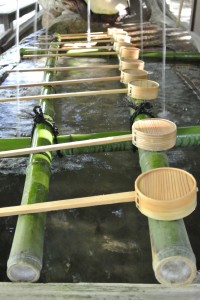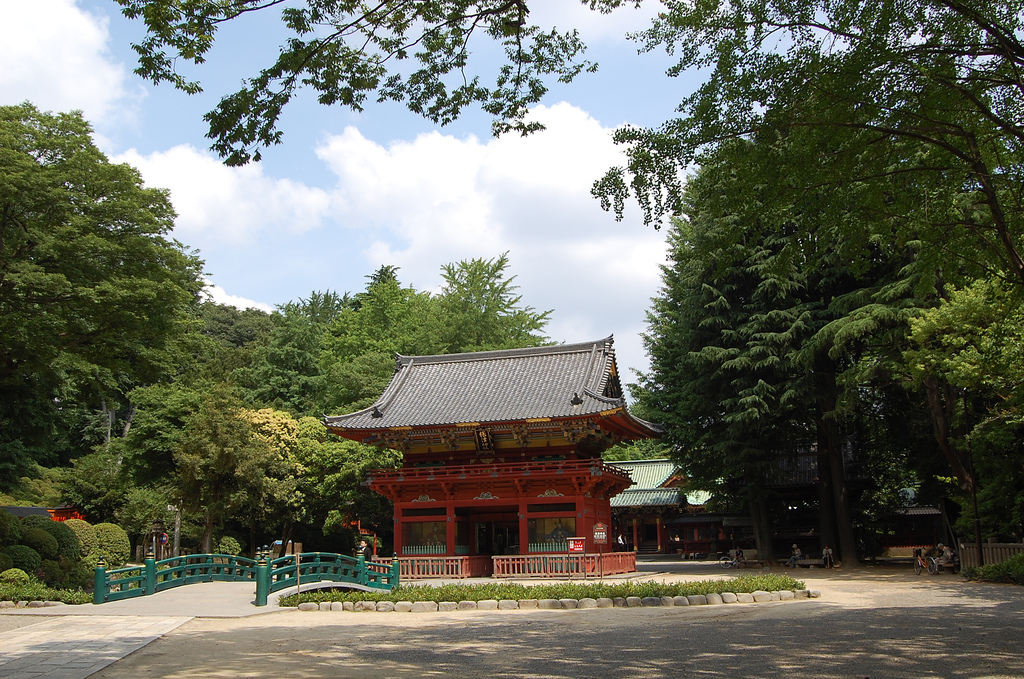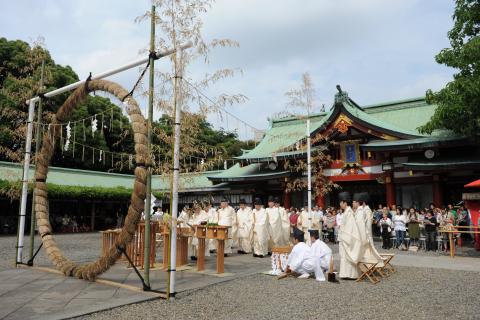One of the key points of Shinto is the notion of renewal, in tune with the perennial ability of nature to renew itself. Here Kevin Short, naturalist and cultural anthropologist, writes of his visit to Shinobazu Pond in Tokyo. (Daily Yomiuri, July 5 2012)
***************************************************************
On this day the star is a mother karugamo spot-billed duck resting peacefully in the shade with her brood of five ducklings. The spot-billed is the only species of duck that breeds regularly in the Tokyo area. Shinobazu Pond, with its dense reed bed, is an ideal nesting spot. Spot-billed ducks lay up to a dozen eggs, but some ducklings fall prey to huge hashibuto-garasu jungle crows, and others to the big aodaisho rat snakes, Benzaiten’s sacred familiar spirits that prowl around the edge of the pond.

Despite all these natural and cultural attractions, my lady friend and I do not linger at the pond. We pay our respects to the water goddess, then set off walking northward along Shinobazu-dori. This avenue skirts the edge of the zoo, then enters the mouth of a narrow valley formed between the Yanaka Cemetery on the east and the University of Tokyo and the Hongo-daichi Uplands on the west.
Our destination, the Nezu Shrine, is nestled into the valley’s western slope, just north of the university baseball field. We stop for a cup of coffee on the avenue. My friend, who combines traditional spirituality and aesthetics with a complete mastery of state-of-the-art digital communication devices, conjures up an aerial photograph on her tablet. The shrine is easy to pick out–it is surrounded by a magnificent sacred grove comprising several dozen venerable old trees.
The current shrine buildings date to the 18th century, but legend holds that the shrine was first founded nearly 2,000 years ago by the great mythological hero Yamato Takeru. On this day in late afternoon, the grounds are cool and shaded, but surprisingly crowded. In front of the entrance to the inner shrine stands an immense wreath, well over four meters high, woven of twisted straw.
Today, my guide tells me, is the last day of June, time for the Nagoshi-no-Oharae, or “Summer-surviving Great Purification Ceremony.” The ceremony is scheduled to start at 6 p.m., but participants and priests are already milling about. The atmosphere is charged with pleasant anticipation.
“During the course of our daily lives,” she explains. “Various impurities collect unnoticed like sludge or muck in our bloodstream, and stick to our spirits like grime or plaque. These are caused by petty emotions like irritation, anger, jealousy, impatience and dislike. As it builds up over the months this gooey junk slows us down and tires us out, and can cause stress and even illness. The purification ceremony flushes the stuff out and resets our body spirit back to a more natural and comfortable state.”

Hitogata
The purification is a two-step process. We start by writing our name and age on a small piece of paper cut out in human shape. Then we blow on the paper and rub it across our foreheads. A priest explains, “This transfers some of the impurities to the paper doll, which is disposed of later.”
“The wreath contains straw from reeds and other water grasses,” he continues. “In the natural world, these plants help purify the water by fixing excess nitrogen and pollutants in their roots. In like manner the straw can remove the remaining impurities from the hearts and spirits of humans as they pass through the wreath.”
By the time we join the line it stretches out the main gate and all the way down to Shinobazu-dori. We pass through the wreath once, circle around to the left, then pass through again and circle to the right. Finally we pass through a third time and continue straight on to pay our respects at the shrine, after which we receive a miniature straw wreath charm that will energize and protect us until the New Year’s Eve.
“I feel like I just changed the oil and cleaned the spark plugs on my car!” enthuses one young office worker. “It’s like getting rid of all the unneeded files on your spiritual computer desktop!” adds another. The ceremony is held only once, but the wreath will be left up for a few weeks for those who wish to purify themselves on their own.



Leave a Reply